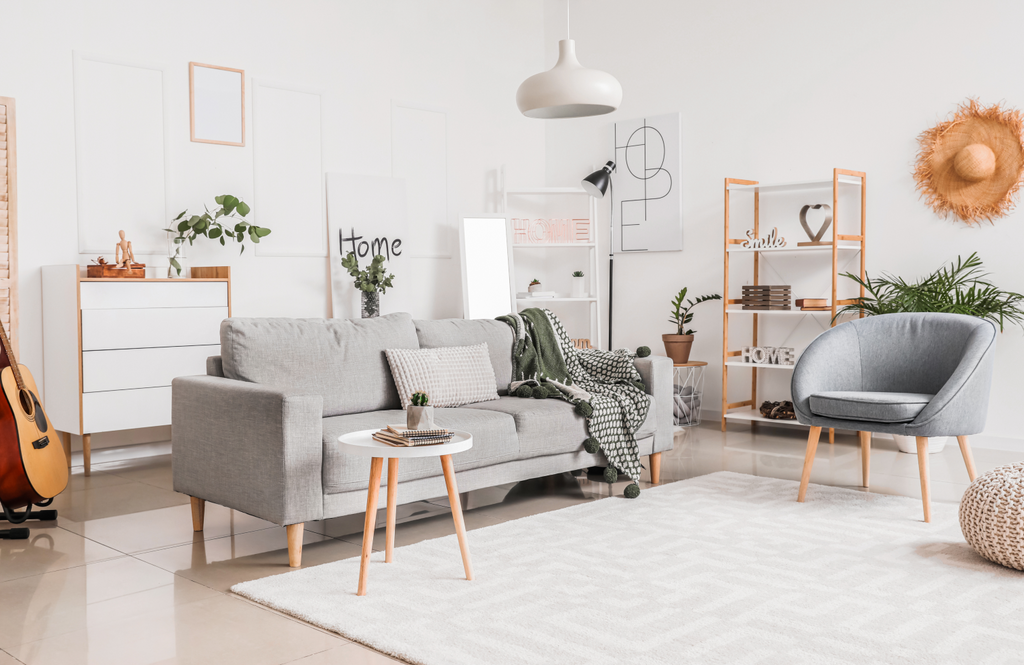
10 Tips for How To Arrange Living Room Furniture

The living room is a space where you wish for everyone to feel welcome and comfortable. A big part of that comfortability is how the room is arranged. How the living room feels will set the tone for casual family lunches or festival holiday get-togethers.
Note: While living rooms and family rooms are often considered to be different rooms, there is a lot of crossover. Living rooms tend to be a tad more formal, but many of these living room layout ideas work just as well in a family room.
With any room, creating the perfect space comes down to what you put and where. So without further adieu, let’s get to the ten decor ideas that will inspire your next magazine-worthy space.
Create a Focal Point
There should be a central area within your living room that directs the attention of not only the furniture and its direction but also the guests as well. Your living room may have a built-in focal point already, such as a large window or a corner fireplace, and if there isn’t one already, add one!
For an elegant touch, add in a chandelier — crystal, waterfall, drum, or Sputnik — the different styles of chandeliers are endless. In addition to sconces, this sparkling addition is practical and fashionable — more light helps a small space seem larger.
After you know where your focal point is, place all your furniture towards or in relation to this spot. Adding this simple aspect to your living room will make arranging furniture much easier.
Think About What Kind of Layout You Want
There are multiple types of layouts you can utilize for the layout and furniture of your living room.
Consider:
Symmetrical
A symmetrical layout will offer a sense of balance and organization in your space, plus it’s pretty easy on the eyes.
Minimalist Layout
A minimalist layout will have minimum furniture and a small number of accent pieces that will make the space feel cozy and calm but never cluttered. Use this layout if you are a “less is more” person or if you want to keep a small living room airy.
Family-Friendly Layout
This type of arrangement will provide plenty of space for a number of guests. You can achieve this with an L-shaped sectional sofa with two to three smaller chairs.
Or, you can pair another loveseat with the L-shaped couch and have a wider coffee table in the middle of the room.
Integrated Dining Zone Layout
This layout would see your dining room bleeding into the setup of your living room. Not only does this add more variety in furniture, but it also will make your living room seem more open and cohesive. (This is easiest with open-concept floor plans.)
Create a Conversation Area
The living room should be an area where people can communicate with one another, so allow your furniture to make this process easier.
You can do this in a number of ways, but including extra seating makes this simpler. Consider armless room chairs so whoever is seated can freely twist in any direction to chat with everyone. Add in a matching ottoman footrest stool for maximum relaxation.
Think About the Flow of the Room
When people are making their way through your living room, they should not have to hop and leap over a footstool that seems a little too close to the coffee table, which is tightly packed up against the couch.
Before finalizing the living room furniture arrangement, pull out a roll of painter’s tape to ensure you have enough floor space for the furniture (and the home’s residents).
For example, mark off the needed walkways so that large pieces like armchairs don’t get in the way. If you’re bringing in a grand bookshelf, mark off the wall space on that side of the room to know where to hang family pictures and other artwork around the shelving and make the room look even.
Test it yourself by walking through the paths you have made with the furniture and test if it seems cramped in any sort of way. If so, rearrange some pieces so that it is easier to move through the room with ample space. This is particularly critical for narrow living rooms.
Mix Up Your Lighting
Lighting fixtures can be an easily forgotten part of living room furniture, but they are still incredibly important in creating a cohesive energy in your living space. Make sure your lighting has a mix of floor lamps, table lamps, and overhead lighting.
Also, mindfully place lighting fixtures around the room and furniture; perhaps one above a sizable piece of wall art and another on a side table opposite that. This ensures that each portion of the room is well-lit and there is diversity in your lighting.
Keep Proportions In Mind
If you plan on hanging up any sort of wall art or mirrors — basically anything that will be hanging above a piece of furniture, make sure that the proportions will match well and look good against their counterparts.
For instance, if you have a larger painting and you are wondering where to place it, it probably would not look best behind the small accent chair; the proportions will be very off. Instead, a better place for it would be above your sofa or maybe another bigger piece of furniture.
Making sure things are proportional in relation to the furniture of the room will make the space seem more aesthetically pleasing and have a stronger overall feel to the room.
Get a Large Coffee Table
The coffee table in your living room should be a point of attention and should be fairly big in comparison to some of the other items in the room. The larger the table, the easier it is to provide a focal point and the easier it will be to place seating areas around the table.
The table should function as an additional focal point for any sort of additional furniture. It actually becomes easier to create a layout when the coffee table is bigger because you can build the rest of the room around it.
Additionally, a bigger coffee table will allow for more storage space and spots where you can put perhaps less aesthetically pleasing aspects of the room, like WiFi routers and remotes. If a coffee table won’t fit or you don’t love the look, incorporate a storage-capable footrest to hold blankets, board games, or other miscellaneous items.
Think About Rug Size
The rugs in your living room, if it is not already carpeted, should go beneath almost every piece of furniture you have in the living room if that is possible. This makes the room feel more central and gives it more of a complete look.
Obviously, some area rugs won’t be big enough to encompass all of the furniture you have in a given room, and that’s okay.
Just try and make sure at least all of the front legs of pieces are lying on the rug. This should make the area look much nicer as opposed to a living room that would be lacking any sort of rug.
Balance the Furniture
When it comes to furniture arrangement, there’s nothing wrong with an excess of furniture in your living room as long as it is placed correctly. For instance, we don’t want all of the smaller furniture grouped together in one corner of the room and all larger pieces in the opposite corner.
Strategically placing the furniture with variety in mind will make the space look much nicer; have the large L-couch go next to the end table, or a thin floor lamp could be placed next to the loveseat.
Whatever it is, always make sure you put some effort into showing the variety of your pieces; furniture layout is about balance.
Figure out TV Positioning
This can sometimes be one of the hardest things to determine when setting up your living room. The TV placement can bring a room together… or it can throw the balance off in the entire room.
How low or high to hang a TV is always a point of contention amongst designers. To make it simple, consider hanging it 42 inches above the floor — this ensures it will generally be at eye level when seated.
Final Thoughts: Home Decor and Living Room Design
Finalizing the living room layout might seem like a big task, but remember that room decor (unlike your home’s floor plan) isn’t set in stone.
So, this aspect of interior design should be a fun process! With these tips, you should be able to easily create the living room you have always dreamed of.
Remember ideas like arranging your furniture around a focal point, picking a specific layout you wish to stick with, rug size, and so on, and the room will come together almost by itself! Run back to this article if you ever need a refresher on these tips
Sources:
How High to Mount Your TV for Optimal Comfort | The Spruce
What's the Difference Between a Family Room and a Living Room? | Southern Living
Open Floor Plan: History, Pros and Cons | The Spruce
Quick Guide on All the Chandelier Types and Styles Available | ASU



